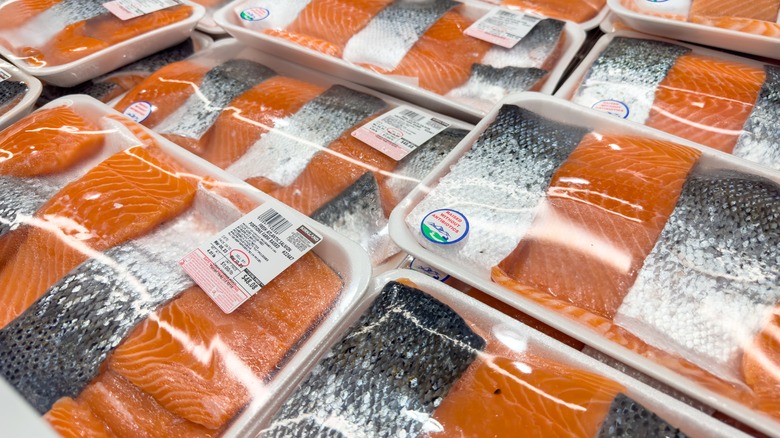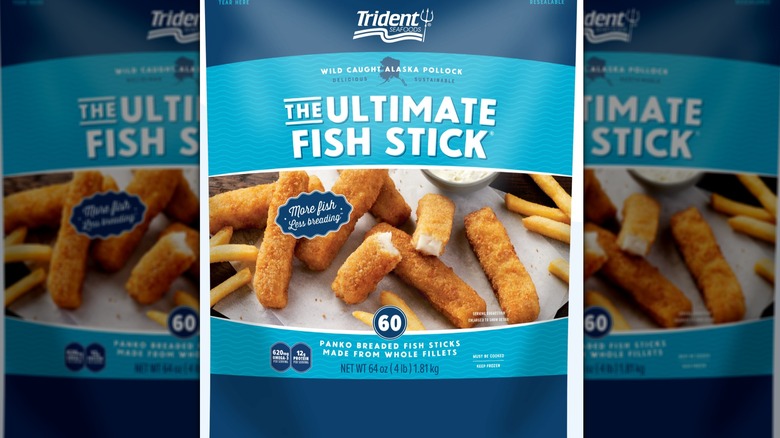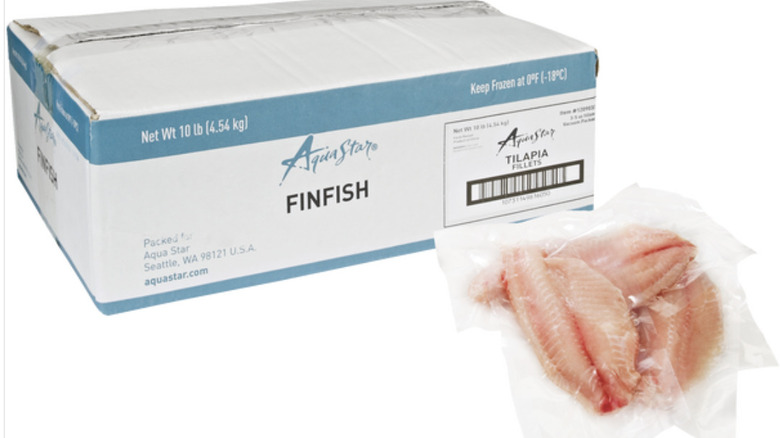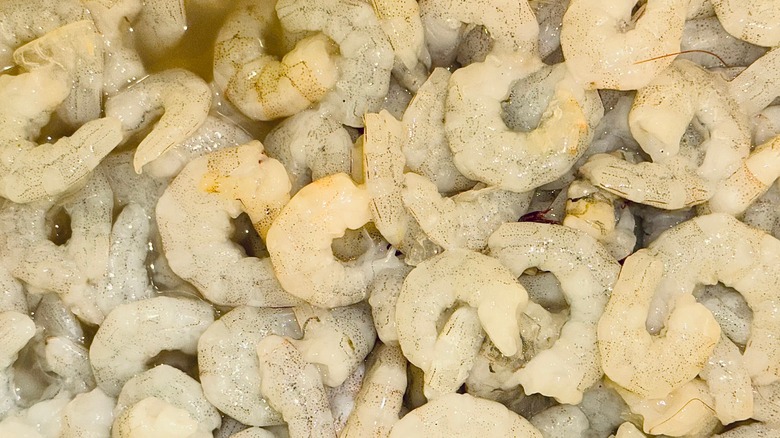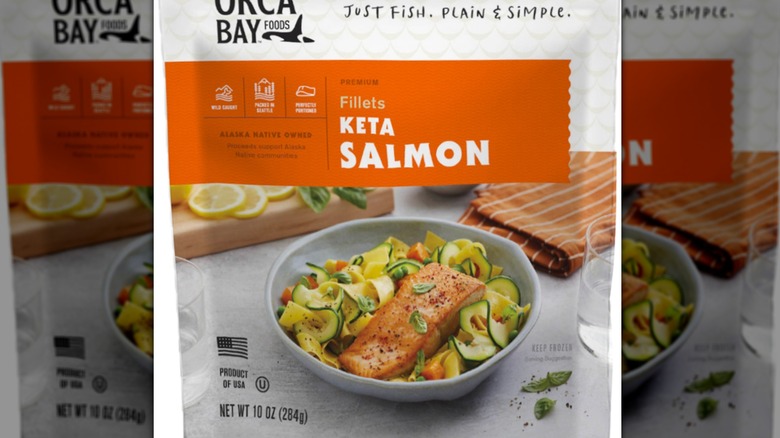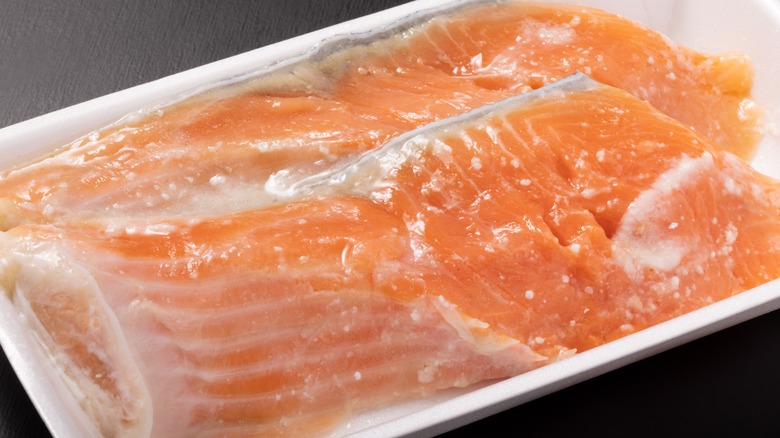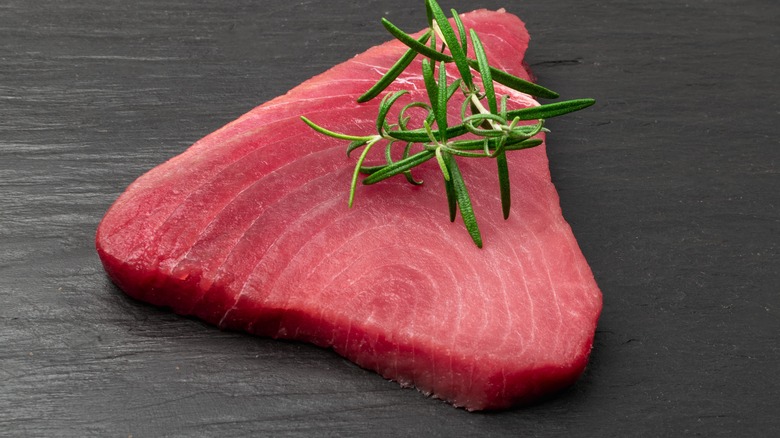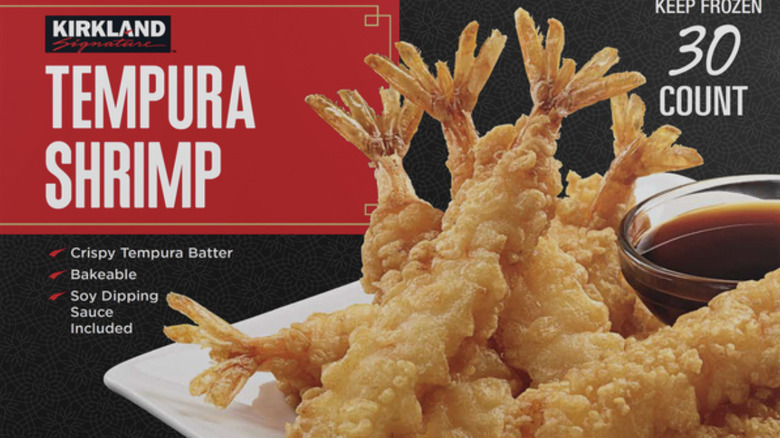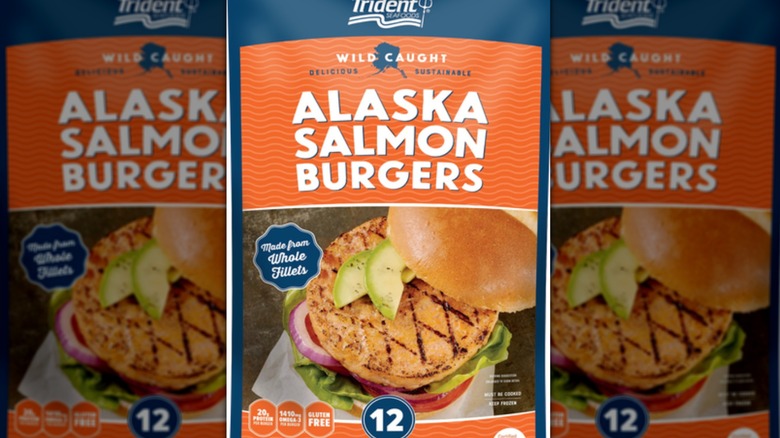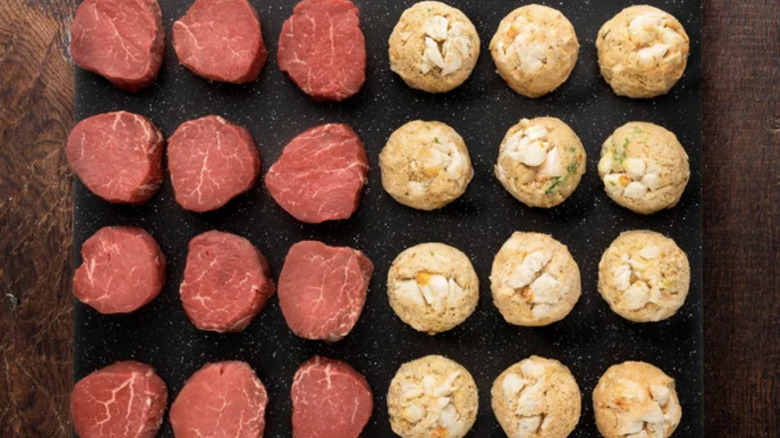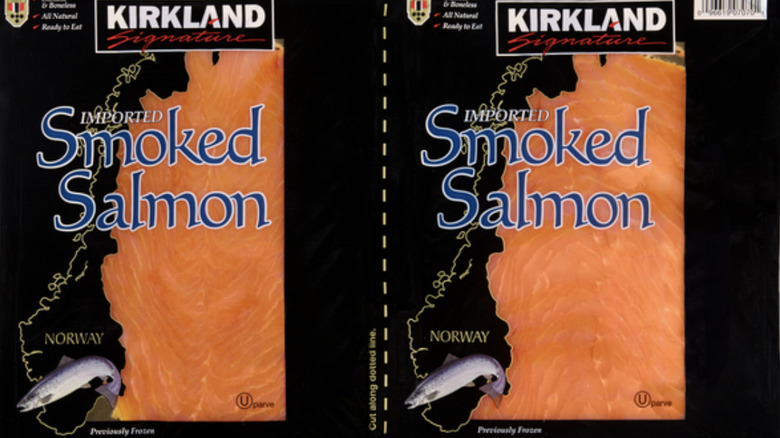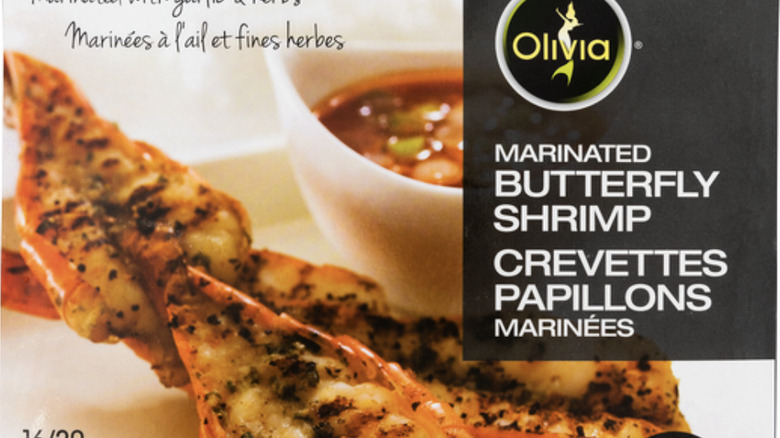Seafood Items You Should Never Buy At Costco
We may receive a commission on purchases made from links.
Costco, a retail behemoth of gigantic warehouse, members-only stores, tries to offer all things to all people, be it regular things in huge quantities or special things in small quantities. The only thing all that merchandise has in common is that it's all reasonably affordable on a per-unit basis, so cheap that customers must wonder how the chain can even make a profit selling premium items, like high-quality seafood, for such a relatively low cost. While wandering through the average Costco with unlabeled aisles, one might be tempted to buy as much seafood as possible and fill their fridge or freezer. There's certainly a lot to choose from, as Costco offers more fish, and more varieties of fish, than almost anywhere short of a cruise ship buffet, from tuna steaks to crustaceans to salmon in various styles and forms, all of it shipped in from all over the world.
If it sounds too good to be true, it's because it's sometimes exactly that. Among the tips and tricks that Costco members need to know is how to avoid the seafood, frozen and fresh, which isn't wise to buy, for reasons relating to health, finances, or otherwise. Here are all the seafoods you should probably never purchase at your local Costco warehouse store.
Trident Seafoods' The Ultimate Fish Stick
A bulk, warehouse-style store like Costco is purpose-built for customers to stock up on household staples, which includes huge bags of family-friendly foods. Costco often stocks 60-count bags of The Ultimate Fish Stick, made by Trident Seafoods. The name implies an elevated version of the mundane frozen entree, as it's made with seemingly high-quality pollock caught off the shores of Alaska, cut into strips and breaded in airy, Panko-style bread crumbs.
But descriptions and packaging photos can be deceiving. Fish is more expensive than breading, and so these sticks have less seafood than expected — about ⅓ of each Ultimate Fish Stick is breading. And while Panko is generally light in texture, there's so much piled on here that it buries the fish in a starchy, gloopy mess. Among the additives overrepresented here are sodium and maltodextrin. There's 14% of the USDA's recommended daily allowance of sodium in a serving of three sticks, while maltodextrin is a food additive the body has a hard time processing. It can also lead to blood sugar surges.
Aqua Star Farmed Tilapia Fillets
A couple of decades ago, tilapia was a semi-obscure fish, and today, you can buy a huge cardboard box loaded with 10 pounds' worth of individually vacuum-sealed fillets of the stuff at Costco. Tilapia has become a go-to fish for so many people because it's a mild-tasting white fish, ideal in a variety of cuisines across culinary traditions and relatively inexpensive. To meet the high demand, tilapia has entered the realm of seafood that's extensively farmed out of commercial operations, which is cheaper on the whole than to seek it out in the ocean. Farmed seafood is sometimes produced in ecologically unsound environments where the fish eat industrial-concocted fish meal, not the natural diet that historically provides nutrition and top flavor, though the ethics and quality vary from farm to farm. In some cases, farmed seafood can actually be considered better for the environment than wild-caught.
The tilapia one is most likely to find at Costco isn't caught wild — it's Aqua Star Farmed Tilapia Fillets, pre-packed into moderately hearty servings weighing between 5 and 7 ounces. The main reason to choose tilapia over other very similar white fishes, like cod, haddock, flounder, or halibut, is because of its rock-bottom price. Costco, which built its brand on the cost benefits of buying in bulk, simply charges too much for tilapia to make it worthwhile. A 10-pound Aqua Star box runs about $60 in 2024. That's $6 a pound, much more than the $4.25-per-pound one would pay for a similar product at Walmart.
Imported shrimp
Whether precooked to an appetizing pinkish-orange and sold inside of a round plastic container with a side of cocktail sauce, or presented raw with the tails on or off and packed tightly into large, covered styrofoam trays, there always seems to be a lot of shrimp to choose from at Costco. The little seafood treat is so small, abundant, and popular that it fits in nicely with Costco's bulk-sales business style. But to stock its many hundreds of stores with veritable mountains of shrimp, the company has to do so in a financially efficient manner, which means the quality won't always meet an objectively high standard.
Costco imports much of its shrimp from around the world, relying heavily on distributor Kader Exports. Other countries have different production standards for seafood than does the U.S., particularly as those pertain to sustainability, antibiotic use, and additive safety. Kader is based in Asia and gets its shrimp from a variety of distant waters. The FDA ordered a big recall of Kader-overseen Costco shrimp in 2020 because of an outbreak of salmonella. In 2024, the FDA wouldn't allow the import of some of the company's shrimp because of issues with antibiotics and waste contamination.
Orca Bay Keta Salmon Fillets
There are many different species and varieties of salmon, and one of the world's waterways' most voluminous in oncorhynchus keta. It's generally referred to in the fish industry by its other name: chum. It's cheap because it's plentiful, and it lacks the texture and flavor of other types of salmon because it's extremely oily, making it a good choice for producers making dried or smoked salmon, or salmon-based dog food, such as Purina Beneful Originals. In fact, it's so extensively used in pet food that keta salmon is sometimes also labeled "dog salmon."
Seafood company took this extra-fatty, industrial-grade, non-exceptional salmon and gave it a marketing makeover in order for it to seem exotic or top-shelf. Sold at Costco as Orca Bay Keta Salmon Fillets, it's a tough fish to cook and eat, as it tends to lose that distinctive salmon firmness and as it heats, it turns too soft. Customers who gave it a try haven't been happy with it. "It tasted nothing like normal salmon. It was dry, fishy, and just off tasting," one Costco customer said on Reddit.
Aysen Coho Salmon Fillets
Slapping a "sashimi quality" designation tag on a seafood package doesn't imply any sort of official certification, but it suggests to customers that the fish inside is going to be so fresh and delicate that they can eat it raw, or how they'd find it in a sushi restaurant. The Aysen Coho Salmon Fillets sold at Costco come with a "sashimi quality" label, but it doesn't deliver on what that's supposed to entail.
Fresh fish isn't always better than frozen, but sashimi-worthy seafood should likely be sold as quickly as possible after it's caught. Presented in a bag of precisely measured 6-ounce portions, the Aysen Coho Salmon Fillets are curiously offered by Costco's frozen food section. The fillets need to be thawed before serving or cooking, and the fish can't handle the transition, falling apart into odd chunks. This seafood choice is also something to note if you're watching your fat intake, containing 19 grams of fat and four grams of saturated fat per serving, approaching ¼ of the USDA-advised daily limits, all in just one pretty small piece of fish. And while dietary fat is present, functional fat is not, at least for those who attempt to use the Aysen product for its suggested purpose. "Sashimi salmon needs to have substantial fat marbling, and it's best when the fillets being sliced are skinless. This salmon has neither quality," reads a review from a customer named Ryan.
Ahi tuna
It's hard to pass up wild-caught, de-boned ahi when it's up for grabs right there in the seafood section at Costco. Tantalizingly deep in color and around a couple of inches thick, it's a formidable delicacy, these steak-like portions of a very large and very flavorful wild-caught yellowfin tuna. Costco sells these by the caseload, with about 26 previously frozen and individually vacuum-sealed pieces in a 10 pound box, and even at a regular price of $220, it seems like a bargain. That would be the case if this ahi tasted as good as it looked, which is where the comparisons to restaurant-level fish end.
Seafood processors don't do much to the ahi before it's ready to be sold throughout the Costco network, but it's enough to detract from or even ruin the delicate, not too fishy taste. Some of the things added are two kinds of sodium, along with regular table salt help preserve and flavor the ahi, which has also been oddly treated with beef extract. This big box of ahi tuna is simply too much of a good thing, as the end product tastes and smells weird and doesn't feel like it would have or should have cost more than $200.
Many customers were displeased by Costco's ahi. "What came looked good in the packages, but tasted like Spam when barbecued," said customer Jaysjava. "The steaks are absolutely beautiful, but flavor is off with most of them," added MMey.
Kirkland Signature Tempura Shrimp
It's often a tantalizing notion to re-create the restaurant experience in the comfort of one's own home. Costco's house brand Kirkland Signature produces a 30-count box of tempura shrimp that serves this end. From the looks of the crispy, tempura-battered, tail-on shrimp pictured on the box, it would seem that this item would offer a similar taste and texture to similar items found on the appetizer section in the menus of countless Japanese restaurants and sushi bars. But the Kirkland Signature Tempura Shrimp just doesn't live up to the expectation. While they cook up crispy like restaurant tempura shrimp, this particular brand loses the shrimp taste in the process because of the preponderance of breading — the batter is so thick that Costco customers won't be able to taste much else.
"The tempura shrimp is like 90% breading. Much thicker breading than you get at a Japanese restaurant, with just a teeny little line of shrimp in the middle," a Costco customer wrote on Reddit. "I was very disappointed. It is bland," said another on Reddit.
Trident Seafoods Alaskan Salmon Burgers
Burger technology has advanced to the point where food processors can turn virtually any protein into a patty. For example, fish company Trident Seafoods offers a 12-pack of ¼ pound burgers made from purportedly wild-caught Alaskan salmon, sold by Costco. Trident's Salmon Burger is a solid red meat-free alternative that fits on a bun and can benefit from the same barbecue or burger night condiments. Customers should be able to expect these to come off of a grill or other cooking surface tasting much like fresh salmon lightly cooked, but these patties have been so processed, formed, and shaped that they lose a lot of what was supposed to make them special.
Costco-sold Alaska Salmon Burgers are oddly not fishy enough, barely tasting like salmon. They also don't offer a salmon texture — instead of meaty and flaky, these burgers are rubbery and too chewy. This is a name-brand product you can stop buying — it's probably easier and cheaper to just throw a salmon fillet on a hamburger bun rather than buy these overly prepped imitation burgers. "We had them tonight and let me tell you, they taste terrible," said one unhappy customer on Amazon. "They look even more unappetizing. I wouldn't recommend these and I certainly wouldn't purchase these again."
Rastelli's combo boxes
If a premium steak like a filet mignon is regarded as the fanciest and most elegant cut around, and crab and lobster enjoys a similar stellar reputation, then a Costco customer is sure to impress their dinner companions if they serve up both pricey proteins on one plate during one meal. Through the warehouse store network, seafood and meat producer Rastelli's sells premium dinner boxes consisting of 12, 5-ounce top quality Black Angus filet mignon steaks along with 12 sizable lump crab cakes, or four of the steaks with four cold water-caught Maine lobster tails. Fine, luxurious dining doesn't come cheap — the surf-and-turf sets retail for $349.99 and $189.99, respectively.
That would be a fair price for a steak-and-seafood dinner for a big crowd, if it were of exceptional quality and probably served in a restaurant. But this is average-level beef and shellfish, and it's not even sold fresh, but rather frozen. Customers have particularly called out the seafood element of the boxes as being egregiously subpar. "The crab cakes were fishy and full of breading, not much crab," said a Costco customer named Mike. Customer Beeze reported, "The lobster tail taste very mushy," and an anonymous critic said, "All taste and flavor is missing from the lobster and the meat."
Kirkland Signature Smoked Salmon
While also offering a whole different level of intense, velvety flavor with the fishy edge smoothed out, smoked salmon is a faster and more convenient way to enjoy seafood than off the grill or out of the oven. Smoked salmon is smoky, of course, but also very salty. The average customer ought to eat better smoked salmon, and that's a decision that begins by potentially skipping the Kirkland Signature Smoked Salmon from Costco on account of its displeasing sodium level, if you're watching your sodium intake.
There's a fundamental difference between lox and smoked salmon, but Costco only sells the latter in large, cheap quantities under its Kirkland Signature house brand name. A standard serving of the stuff is just 2 ounces, and it's easy to over-eat it because it's not filling with a mere 70 calorie punch. But that one serving packs 600 milligrams of sodium, or more than ¼ of what the USDA says an adult should safely consume in one day. Even ensuring a 2-ounce serving is tough with this brand of smoked salmon because it often breaks off into oddly shaped chunks and slices.
Olivia Marinated Butterfly Shrimp
It's hard to say no to shrimp, a party food and terrific thing to throw on the grill, particularly when it calls out from a Costco freezer bin in a generous, 2.5-pound box with a close-up image of the promised product's cross-section all charred and glistening. The Olivia Marinated Butterfly Shrimp from Costco can't be denied as far as value, flavor, and convenience are concerned, but the method of preparation has made an otherwise nutritious base product — shrimp — haltingly less nutritious.
A recommended serving size of these cut-open, heavily sauced shrimp is about four small-to-medium pieces. That contains a reasonable 120 calories, but that comes almost entirely from fat and cholesterol. The marinade in this marinated shrimp is based on soybean oil, which contains a substantial amount of one of the most damaging types of fats, omega-6, which if consumed in excess can cause long-term inflammation and a host of health problems.
